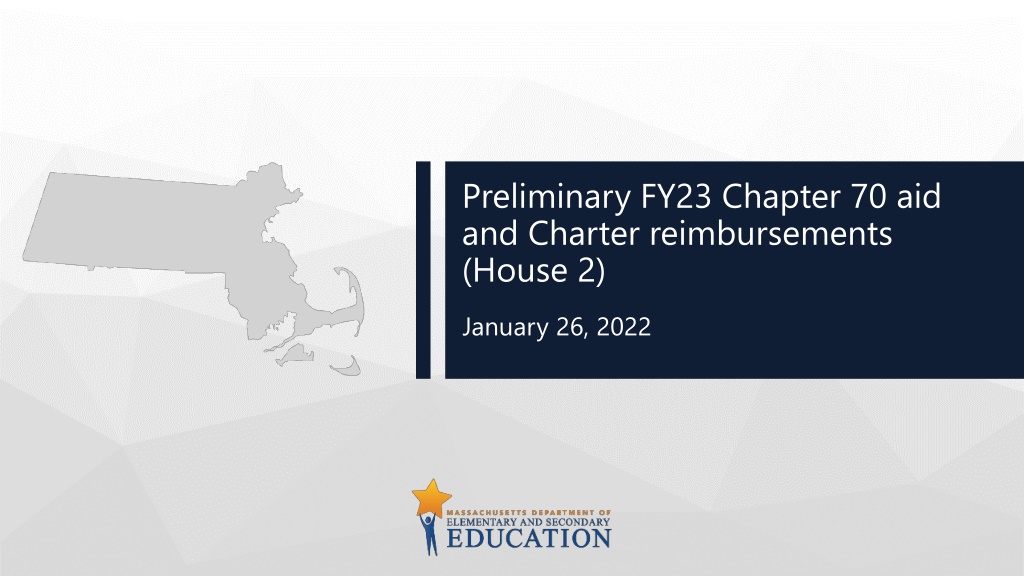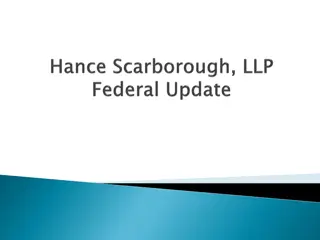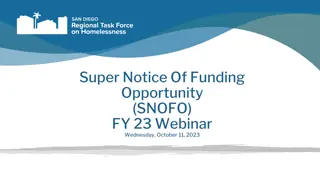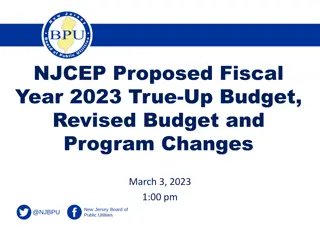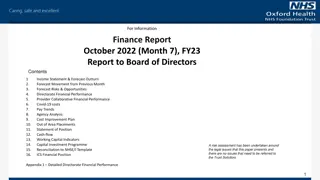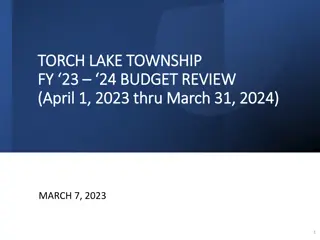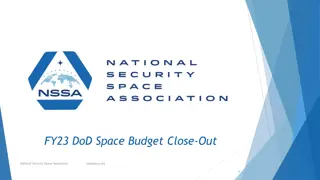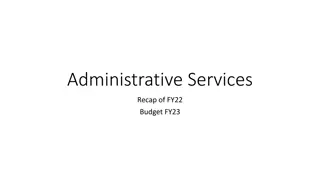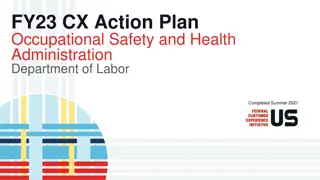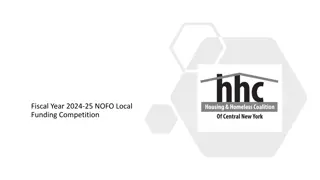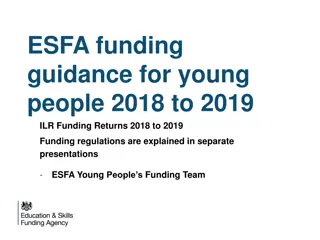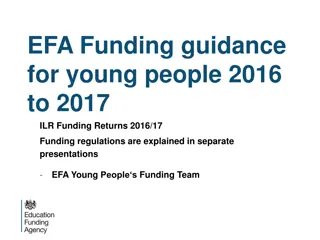FY23 House 2 Chapter 70 Funding Overview
The Preliminary FY23 Chapter 70 aid and Charter reimbursements for House 2 show a significant increase in funding, focusing on areas like benefits, special education, English learners, and more. The Act emphasizes increased rates and closes funding gaps to support student opportunities. Additionally, there are adjustments for inflation and increased assumptions for in-district special education enrollments. Learn more about the proposed changes and impacts for FY23 funding.
Download Presentation

Please find below an Image/Link to download the presentation.
The content on the website is provided AS IS for your information and personal use only. It may not be sold, licensed, or shared on other websites without obtaining consent from the author.If you encounter any issues during the download, it is possible that the publisher has removed the file from their server.
You are allowed to download the files provided on this website for personal or commercial use, subject to the condition that they are used lawfully. All files are the property of their respective owners.
The content on the website is provided AS IS for your information and personal use only. It may not be sold, licensed, or shared on other websites without obtaining consent from the author.
E N D
Presentation Transcript
Preliminary FY23 Chapter 70 aid and Charter reimbursements (House 2) January 26, 2022
FY23 House 2 proposed Chapter 70 funding 01
FY23 House 2 Chapter 70 continues implementation of the Student Opportunity Act (the Act) Preliminary FY23 Chapter 70 is $5,988,520,366, a $485.3 million increase (8.8%) over FY22 The Act establishes new, higher foundation budget rates in 5 areas: o Benefits and fixed charges o Guidance and psychological services o Special education out-of-district tuition o English learners o Low-income students House 2 includes rate changes above inflation toward the goal rates in these 5 areas and closes an additional 1/6thof the gap 3
House 2 sets the low-income threshold at 185% of the federal poverty level in accordance with the Act The Act restores the definition of low-income enrollment used prior to FY17, based on 185% of the federal poverty level, up from the 133% threshold used for the economically disadvantaged match from FY17 to FY22 o Statewide low-income enrollment for FY23 is 407,501, compared to 382,088 for FY22 For FY23, the Department designates a student enrolled on October 1st as low income if the student is: o Identified as participating in state public assistance programs, including the Supplemental Nutrition Assistance Program, Transitional Aid to Families with Dependent Children, MassHealth, and foster care; or o Certified as low income through the new supplemental data collection process; or o Reported by a district as homeless through the McKinney-Vento Homeless Education Assistance program application 4
The Act also increases the assumed in-district special education enrollment percentages The Act increases the rate for vocational students from 4.75% to 5% and from 3.75% to 4% for non-vocational students Proposed rate increases for FY23 close an additional 1/6thof the gaps, so the factors used for FY23 are 4.86% and 3.86%, respectively 5
On top of the targeted rate increases, all foundation budget categories have been adjusted upward to account for inflation An employee benefits inflation rate is applied to the employee benefits and fixed charges category oBased on the enrollment-weighted, three-year average premium increase for all GIC plans oFor FY23 the increase is 4.51% An inflation increase of 4.50% has been applied to all other foundation budget rates, based on the U.S. Department of Commerce s state and local government price deflator and capped at the 4.50% maximum set in the Act 6
The Act also adds a new minimum aid adjustment to the formula This provision provides hold harmless aid to operating districts that otherwise would have lost aid due to the new foundation budget factors oDetermines the aid that these districts would have received if foundation budget rates were only increased by inflation oIf this amount is higher than the revised formula amount, districts get the higher amount 7
The Act codified the aggregate wealth model for determining local contribution requirements For municipalities with required contributions above targets, the requirement is reduced by 100% of the gap Cities and towns with combined effort yields greater than 175% of foundation have required local contributions set at not less than 82.5% of foundation Due to rapid increases to foundation, many communities are below target and fewer are eligible for excess effort reductions o 247 communities are subject to below effort increments to bring their contributions closer to target compared to 52 in FY22 o 27 communities are eligible for excess effort reduction compared to 200 in FY22 8
Charter school tuition and reimbursements 02
Tuition rates for Commonwealth charter schools are based on the same foundation budget rates used in Chapter 70 Foundation budget rate increases being implemented in FY23 have been incorporated into our projected FY23 tuition rates In addition, charter school low-income enrollment for FY23 has been identified using the same eligibility criteria used for districts (see slide 4) 10
House 2 implements the 3-year (100%/60%/40%) schedule for transition aid tied to year over year tuition growth Funding for first year reimbursements is prioritized over funding for second year reimbursements The reimbursement formula for transitional aid to districts reflects the change enacted by Section 38 of the FY20 budget, with an entitlement of 100% of any tuition increase in the first year, 60% in the second year, and 40% in the third year The Act requires that 90% of the total state obligation to be funded in FY23 and 100% in FY24 and subsequent years House 2 allocates $219.4 million for these reimbursements o This appropriation level is expected to meet or exceed the 90% requirement when tuition assessments are updated to reflect actual enrollments and district spending levels The facilities component of the tuition rate is $1,088 per pupil, with this cost fully reimbursed by the state as in prior years 11
Calculating Chapter 70 local contribution requirements and state aid 03
Goal of the Chapter 70 formula To ensure that every district has sufficient resources to meet its foundation budget spending level, through an equitable combination of local property taxes and state aid. 13
The updated formula includes three parameters to be specified in each year s general appropriations act In House 2, these are specified as: oTotal state target local contribution = 59% oEffort reduction = 100% oMinimum aid = $30 per pupil 14
There are 6 factors that work together to determine a district s Chapter 70 aid Foundation Budget Enrollment Wage Adjustment Factor Inflation Local Contribution Property value Income Municipal Revenue Growth Factor 15
There are three primary steps in determining each districts Chapter 70 aid Determine an equitable local contribution requirement, how much of the foundation budget that should be paid for by each city and town s property tax, based upon the relative wealth of the municipality Define and calculate a foundation budget for each district, given the specific grades, programs, and demographic characteristics of its students Calculate state aid, providing necessary funds to reach foundation or mandated minimum aid increases Local Contribution + State Aid = a district s net school spending (NSS) requirement This is the minimum amount that a district must spend to comply with state law 16
Each district's foundation budget is calculated by multiplying the number of pupils in 13 enrollment categories by cost rates in 11 functional areas FY23 Chapter 70 Foundation Budget 239 Plymouth 6 8 9 10 11 12 13 14 Base Foundation Components 3 4 Incremental Costs Above the Base 10 English learners PK-5 1 2 5 6 7 8 9 11 12 13 14 ------ Kindergarten ------ Junior/ Middle High School Special Ed In-District Special Ed Tuitioned-Out English learners 6-8 English learners High School/Voc Low income Pre-school Half-Day Full-Day Elementary Vocational TOTAL Foundation Enrollment 191 0 548 2,639 1,744 2,061 680 303 70 164 55 45 2,693 7,768 1 Administration 2 Instructional Leadership 3 Classroom & Specialist Teachers 4 Other Teaching Services 5 Professional Development Instructional Materials, Equipment & Technology* 7 Guidance & Psychological Services 8 Pupil Services 9 Operations & Maintenance 10 Employee Benefits/Fixed Charges* 11 Special Education Tuition* 41,953 75,767 347,419 89,102 13,740 0 0 0 0 0 240,727 434,777 1,993,569 511,312 78,882 1,159,269 2,093,751 9,600,280 2,462,322 379,928 766,111 1,383,669 5,583,107 1,171,366 272,165 905,363 1,635,173 9,702,762 1,152,409 311,869 298,713 539,504 5,442,249 380,222 170,120 918,630 236,845 17,204 30,105 210,730 30,105 8,600 6,090 10,656 74,592 10,656 3,045 4,649 8,136 56,948 8,136 2,324 181,773 861,167 8,406,687 44,449,587 0 407,837 4,777,328 7,072,703 0 0 0 3,031,244 2,830,230 146,224 3,618 8,649,478 1,794,735 0 6 48,489 30,336 10,054 96,474 124,454 0 0 0 0 0 0 278,252 174,091 57,714 553,586 714,132 1,339,979 838,371 416,845 2,665,901 3,439,118 885,533 655,935 449,980 1,909,986 2,388,425 1,674,356 910,343 1,226,251 2,188,551 2,527,116 966,749 300,356 404,586 1,351,418 1,137,620 123,076 0 0 0 0 0 20,735 12,901 4,303 51,607 45,620 7,340 4,567 1,522 18,267 16,147 5,603 3,486 1,162 13,946 12,328 60,296 340,395 1,768,859 5,410,409 3,270,782 4,341,276 9,875,888 0 0 1,026,150 1,122,251 0 1,311,329 12,838,541 0 0 0 0 0 0 0 0 2,168,486 0 0 0 2,168,486 12 Total 877,788 0 5,037,043 24,395,765 15,466,277 22,234,193 10,991,536 9,197,806 2,408,949 431,910 152,881 116,719 13,338,344 104,649,212 13 Wage Adjustment Factor *The wage adjustment factor is applied to underlying rates in all functions except instructional equipment, benefits and special education tuition. 103.7% Foundation Budget per Pupil 13,472 14 Low-income percentage 15 Low-income group 35.54% 6 English learner foundation budget as % total foundation budget Low-income foundation budget as % total foundation budget 0.7% 12.7% All of your students are counted in categories 1 7; special education, English learner, and low-income costs are treated as costs above the base and are captured in 8 13 17
Foundation budgets vary based on student needs, including concentrations of low-income students Foundation budget per pupil, by low-income % range 0.00 - 5.99% $11,077 6.00 - 11.99% $11,755 12.00 - 17.99% $11,912 18.00 - 23.99% $12,023 24.00 - 29.99% $12,190 30.00 - 35.99% $12,720 36.00 - 41.99% $13,007 42.00 - 47.99% $13,988 48.00 - 53.99% $14,542 54.00 - 69.99% $14,867 70.00 - 79.99% $16,702 80.00%+ $16,988 State average $14,072 Note: Chart excludes vocational and agricultural districts. 18
Determining each municipalitys target local share starts with the local share of statewide foundation Determine target local share of statewide foundation Statewide, determine percentages that yield from property and from income Calculate statewide foundation budget 41% State aid $5.285B Statewide foundation budget $12.890B Income effort 1.5242% $3.803B 59% Local contribution $7.605B Property effort 0.3624% $3.803B Property and income percentages are applied uniformly across all cities and towns to determine the combined effort yield from property and income. 19
An individual municipalitys target local share is based on its local property value, income, and foundation budget The sum of a municipality s local property and income effort equals its Combined Effort Yield (CEY) 2019 aggregate income X Statewide Income % 1.5242% CEY 2020 EQV X Statewide Property % 0.3624% Target Local Share = CEY/Foundation budget (calculated at the city/town level) o Capped at 82.5% of foundation (168 municipalities or 48% are capped) 20
Next the formula calculates each municipalitys preliminary local contribution (PLC) and makes adjustments relative to target to determine the required local contribution (RLC) Preliminary contribution Required contribution If the PLC as a % of foundation > target Reduce PLC by 100% of the gap Increase last year s required local contribution by the MRGF If the difference is < than 2.5%, the PLC is the new requirement If the difference is between 2.5% and 7.5%, add 1% to PLC Municipal Revenue Growth Factors (MRGF) are calculated annually by the Department of Revenue. MRGFs quantify the most recent annual % change in each municipality s local revenues, such as the annual increase in the Proposition 2 levy limit, that should be available for schools If the PLC as a % of foundation< target If the difference is > 7.5%, add 2% to PLC 21
Once a city or towns required local contribution is calculated, it is allocated among the districts to which it belongs Town of Dartmouth Foundation budget = $49.8M Required local contribution= $39.0M Greater New Bedford 14% Greater New Bedford 14% Bristol County 1% Bristol County 1% Dartmouth 85% Dartmouth 85% 22
Foundation aid provides additional funding for districts to spend at their foundation budgets Foundation budget Required local contribution = Foundation aid Start with prior year s aid Add together the prior year s aid and the required local contribution If this year s foundation aid exceeds last year s total Chapter 70 aid, the district receives the amount needed to ensure it meets its foundation budget (3) Foundation aid increase Prior year s aid (1) Foundation budget (2) This year s required local contribution 23
Calculating Chapter 70 aid: Districts are held harmless to previous aid levels and guaranteed at least a $30 per pupil increase Districts are held harmless to the previous year s level of aid 135 districts receive minimum aid increases of $30 per pupil over FY22 FY23 Chapter 70 Summary 670 Frontier Aid Calculation FY23 Prior Year Aid 1 Chapter 70 FY22 2,872,335 Foundation Aid 2 Foundation budget FY23 3 Required district contribution FY23 4 Foundation aid (2 -3) 5 Increase over FY22 (4 - 1) 6,777,309 5,342,316 1,434,993 0 Minimum Aid 6 7 Minimum $30 per pupil increase Minimum aid amount (if line 6 - line 5 > 0, then line 6 - line 5, otherwise 0) 15,450 15,450 Subtotal 8 Sum of 1,5,7 2,887,785 Minimum Aid Adjustment 9 Minimum aid adjustment 10 Aid adjustment increment (if line 9 - line 8 > 0, then line 9 - line 8, otherwise 0) 2,887,785 0 Non-Operating District Reduction to Foundation 11 Reduction to foundation 0 FY23 Chapter 70 Aid 12 Sum of 1,5,7,10 minus 11 2,887,785 24
Districts receive different levels of Chapter 70 aid because their municipality s ability to pay differs 100% 90% 80% 70% 60% State Aid % Net School Spending 50% Local Contribution 40% 30% 20% 10% 0% 25
The aggregate wealth model has eliminated required excess effort, but in recent years effort shortfalls have increased For communities that are below target, recent expansions in foundation budgets have resulted in required contributions not keeping pace with the foundation budget increases 26
There are no longer any districts funded below target, while above target aid has increased 27
Questions? QUESTIONS? Rob O Donnell, Director of School Finance Rob Hanna, State Aid Programs Manager Robert.F.O Donnell@mass.gov Robert.Hanna@mass.gov 781.338.6512 781.338.6525
